In this guide, you’ll learn how to create a B2B marketing strategy and what tactics you should use. We’ll also look at some successful B2B marketing examples.
But first, some fundamentals:
- What B2B marketing is
- B2B vs. B2C marketing
- Create a B2B marketing strategy
- B2B marketing tactics
- B2B marketing examples
B2B marketing (short for business-to-business marketing) is the process of promoting products or services to another business or organization.
B2C marketing is short for business-to-consumer marketing and is the process of promoting products or services to individuals (who are buying things for their personal use).
Examples include buying clothes from Uniqlo, an iPhone from the Apple store, or a car for your personal use.
While B2B and B2C marketing seem like opposites, they’re not mutually exclusive. Many businesses sell to other businesses and consumers. For example, a local bakery may sell baked goods to walk-in customers and also provide canapes for business events. Such businesses will have to do both types of marketing.
However, don’t let the term “B2B marketing” mislead you. Ultimately, a business is made up of people. So B2B marketing still involves marketing and selling to people.
The main difference is B2C marketing involves one decision-maker, i.e., one consumer makes the decision. But B2B marketing usually involves more decision-makers (e.g., the team, head of department, CEO, etc.). This means more time, education, and discussions are needed before any purchase decision is made.
Understanding this is crucial to understanding B2B marketing.
Search for B2B marketing on Google, and you’ll find lists of “strategies” you can use. But those are not strategies. They’re tactics.
You can’t throw every B2B marketing tactic on the wall and hope one sticks. It’s inefficient and a waste of time and resources. Instead, you first need a strategy—this will determine the tactics you’ll use.
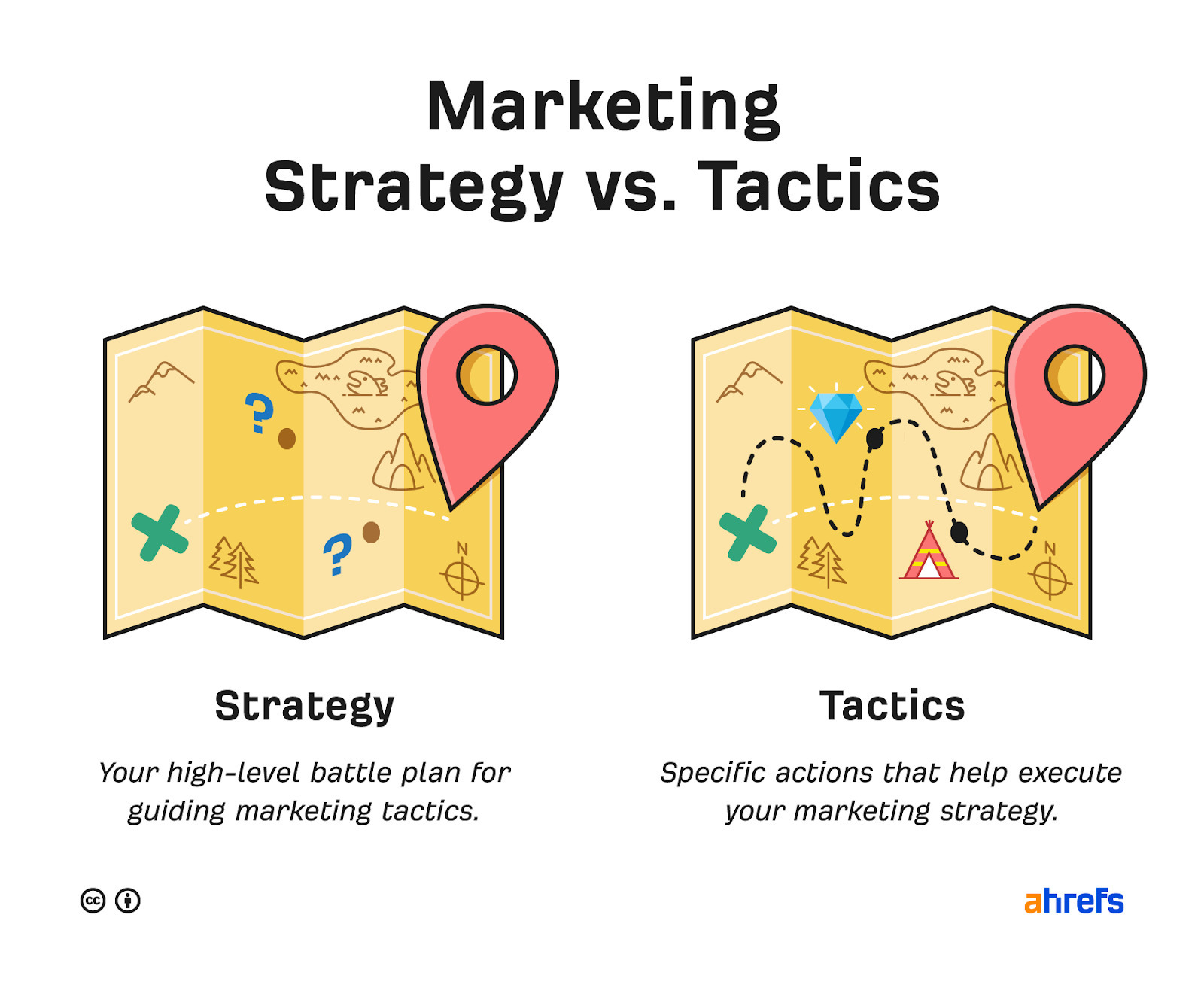
Here’s how to create a B2B marketing strategy.
1. Decide on the customers you’ll target
To choose your target customers, ask yourself these six questions:
- Does your product align with what the segment wants?
- Does it bring you the most value if you increase your market share there?
- Do you have the sales and marketing resources to increase your market share there?
- How difficult is it going to be to increase your market share there?
- Does this segment influence any other segments? If so, how?
- What are the trade-offs if you shift your focus to new segments?
Your ideal target segments are those where you can make the most money, given the resources available.
Remember also that in B2B marketing, the customers who are using your product or service may not be the ones purchasing it. For example, SEOs may be using our toolset, but the final decision-maker may be the head of marketing or even the CFO.
Make sure you’ve done your market research to figure out how the buying process works in your target segment’s industry.
Recommended reading: How to Create a Marketing Strategy in 5 Steps (With Examples)
2. Position your product or service
According to positioning consultant April Dunford, positioning is “the act of deliberately defining how you are the best at something that a defined market cares a lot about.”
With good positioning, customers can easily understand what your product/service is, why it’s special, and why it matters to them. This is important because customers are always evaluating you. Neglect to define this clearly, and customers will invent a position—often one that is non-ideal or misrepresents your product/service and brand.
Plus, a good position differentiates you from your competitors. In some cases, it may even influence how the target market perceives them.
So how do you position your product or service? The best way is to apply the step-by-step framework from April’s book, “Obviously Awesome.”
Here’s a tl;dr. You should:
- Understand who your best customers are (step one!).
- Form a positioning team and align your positioning vocabulary across teams/departments.
- List your competitive alternatives.
- Figure out the attributes and features that make your product/service unique.
- Figure out the true value of these attributes and features. What do they do for your customers?
- Find a target market that cares most about your unique value proposition.
- Capture your positioning in an evergreen document that can be shared across all teams.
Also, if you’re targeting multiple customer segments, make sure you create a different position for each of them. For example, our free tool, Ahrefs Webmaster Tools, is targeted at website owners, and our copy reflects that:

Whereas Site Audit is targeted at seasoned SEOs and marketers. Thus, the position and copy change as well:

3. Set strategic objectives for the year ahead
For your strategy to work, you need to know where to go. Those are your objectives. Set one or two for each of your target segments and align them with the SMART criteria:
- Specific – Clearly state the desirable outcome, answering the who, what, when, how much, etc
- Measurable – Must be able to track progress with Key Performance Indicators (KPIs)
- Achievable – Be bold with your goals, but also realistic; use current growth as a benchmark
- Relevant – Ensure each objective aligns with your overall marketing and business strategy
- Timely – Set up a time frame for achieving the goal
For example, a potential marketing objective for our blog could be:
Grow organic traffic from 300K to 700K by the end of 2022.
Recommended reading: Marketing Objectives: How to Set Them Right (With Examples)
4. Decide on the tactics you want to use
It is only at this point you can begin considering what kinds of tactics you want to use. But you’re not choosing them at random. You’re choosing them based on the strategy you’ve created above.
The way I think about this is by using this mental model from David Fallarme, marketing director of On Deck:

Basically, you need to use the right hunting tools to hunt the right animals.
From step one, you should already know what type of customers you’re going after. They’re typically either:
- Elephants – Worth hundreds of thousands of dollars per year
- Antelopes – Worth tens of thousands of dollars per year
- Rabbits – Worth thousands of dollars per year
- Mice – Worth hundreds of dollars per year
- Flies – Worth a few dollars per year
From here, you can decide what kind of hunting tools you need. There are three main types:
- Spears – Require lots of direct human skill and involvement, like sales and business development. For businesses that target enterprise customers.
- Nets – Pull in a large number of potential targets at once, like content marketing. For businesses that target small businesses.
- Seeds – You plant the seeds with your product or service, and the customer base grows on its own. Examples are word of mouth and virality. For businesses that target small businesses or consumers.
For example, at Ahrefs, our target customer base is worth around $1K-$10K. This is the reason why content marketing is our main B2B marketing strategy. It works so well because it is the right tool for the right animal.
But that’s not all. The tactics you use should match how your target customers consume information. For example, don’t create podcasts if no one in your industry listens to them.
Finally, your tactics should move you closer to your goal. For example, if your goal is to get more organic traffic, then email marketing may not be a good tactic.
Here are some popular B2B marketing tactics worth considering—many of which we continue to use at Ahrefs.
1. SEO-driven content marketing
This is the primary tactic we use at Ahrefs. Simply speaking, we create content around topics that our target customers are searching for.
Here’s how we find these topics:
- Go to Ahrefs’ Keywords Explorer
- Enter a keyword related to our industry (e.g., “SEO,” “marketing”)
- Go to the Matching terms report
- Toggle the Questions tab
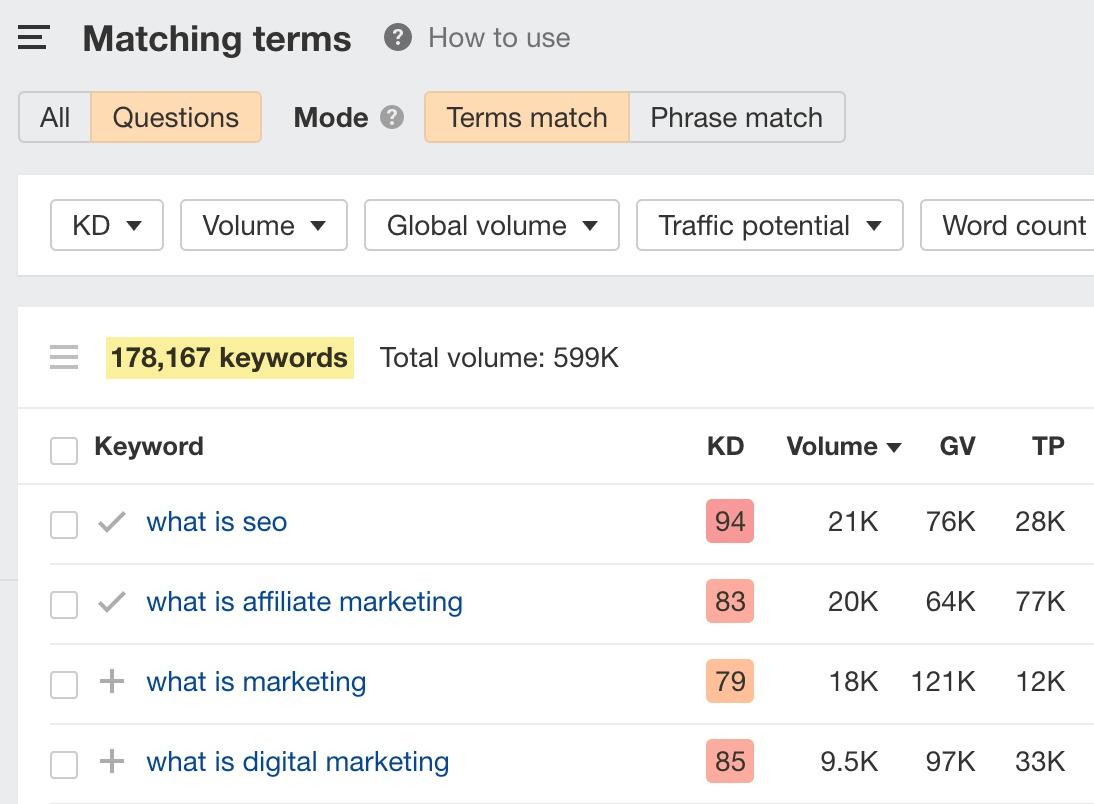
Here, we see tons of keyword ideas and their estimated Traffic Potential. We’ll note down those keywords relevant to us.
Then, we’ll create content designed to rank for those keywords. Here’s the framework we use:
2. Email marketing
The premise of email marketing is simple: collect the contact information of potential customers and email them your branded messages.
First, let’s collect the contact information of your target customers. At Ahrefs, we keep it simple with a “subscribe” box:

You can also offer a “carrot” in exchange for subscribing. Typically, B2B companies like to offer free eBooks, white papers, templates, or courses:
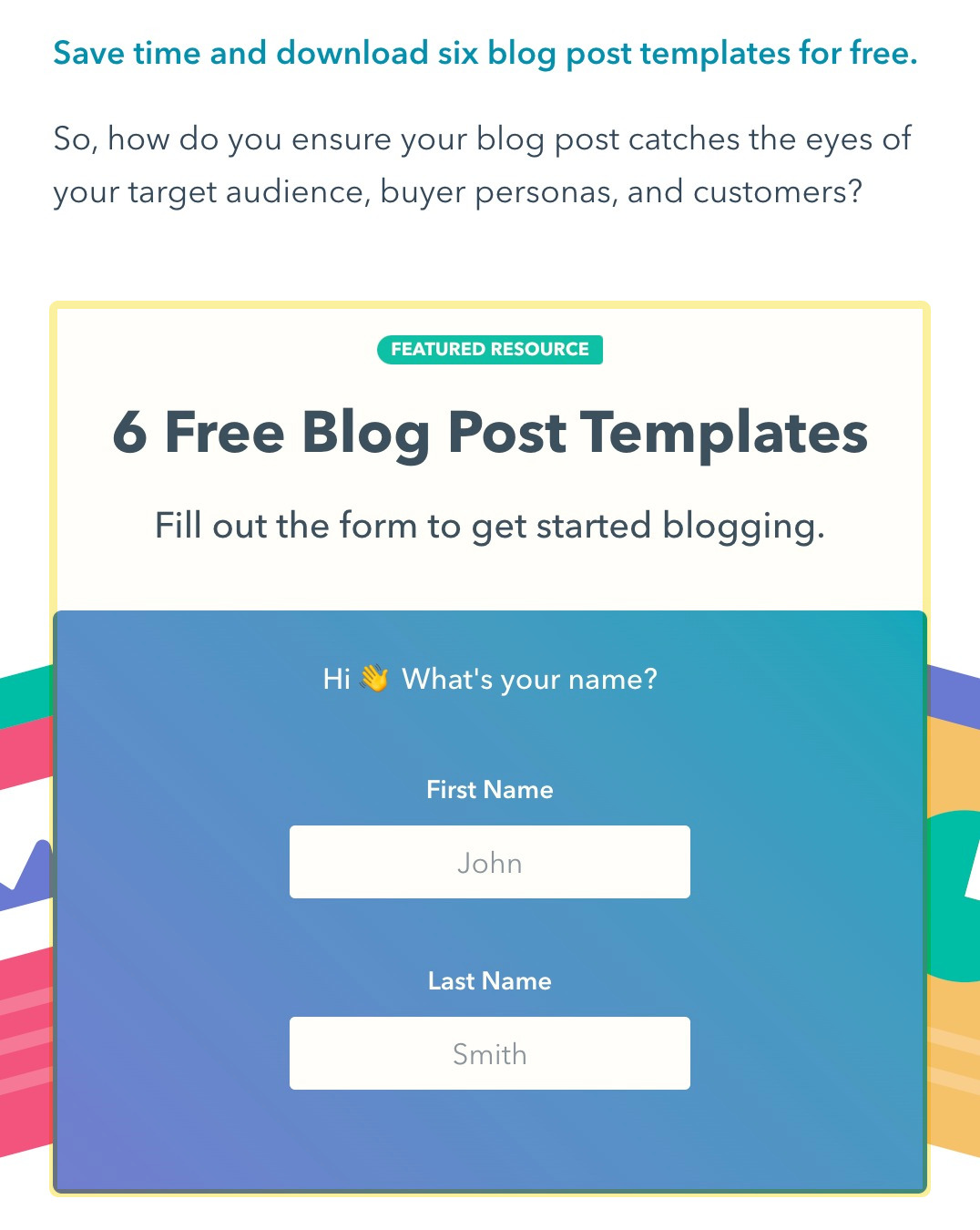
Next, the email. Once again, we keep it simple by emailing our subscribers a weekly digest of what we’ve published and what we’re currently reading:

But the world’s your oyster. Experiment and see what makes sense for both your business and your customers. For example, the marketing agency, Demand Curve, sends a monthly “growth tactics” newsletter.
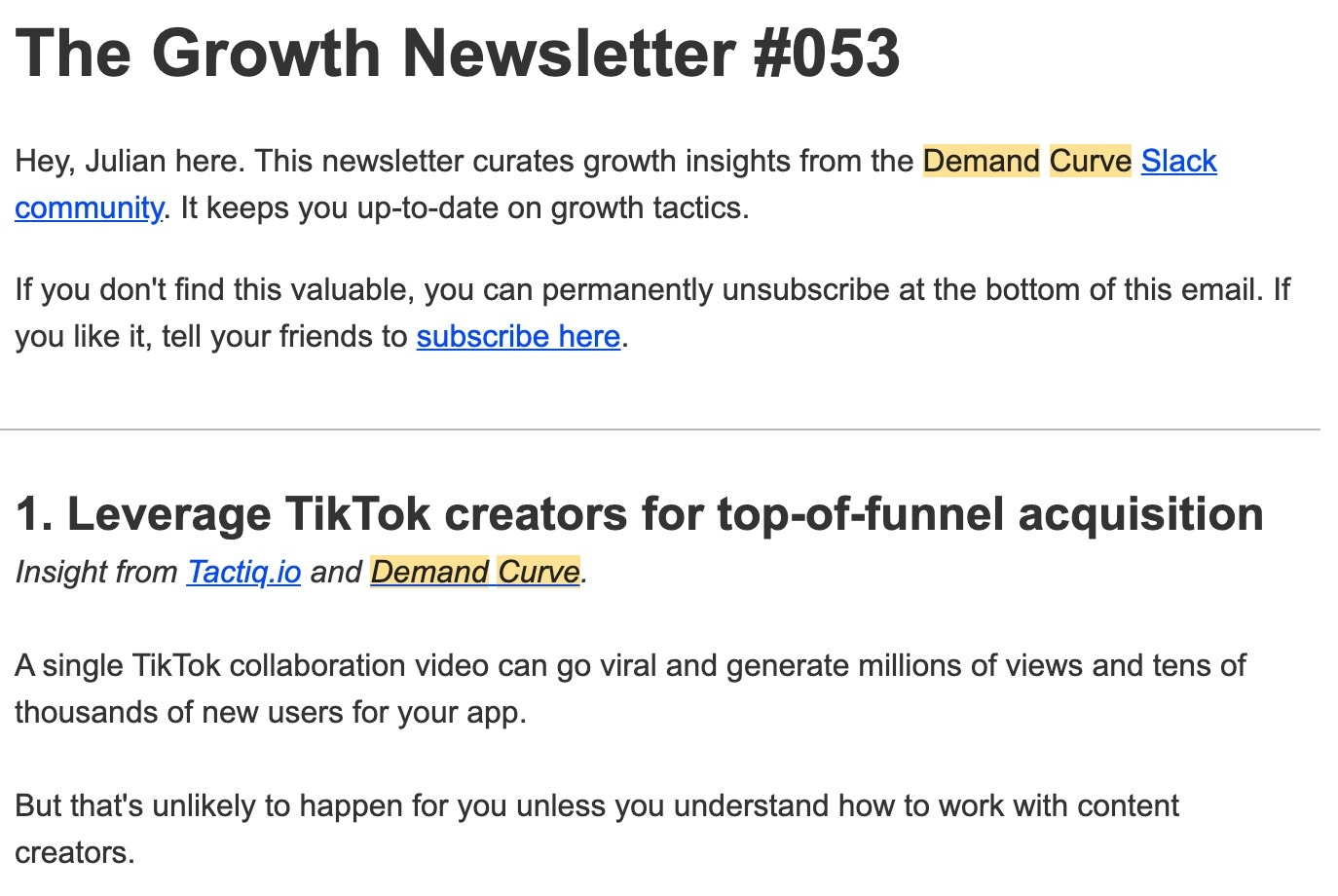
However, it also occasionally sends emails that promote its programs and services:
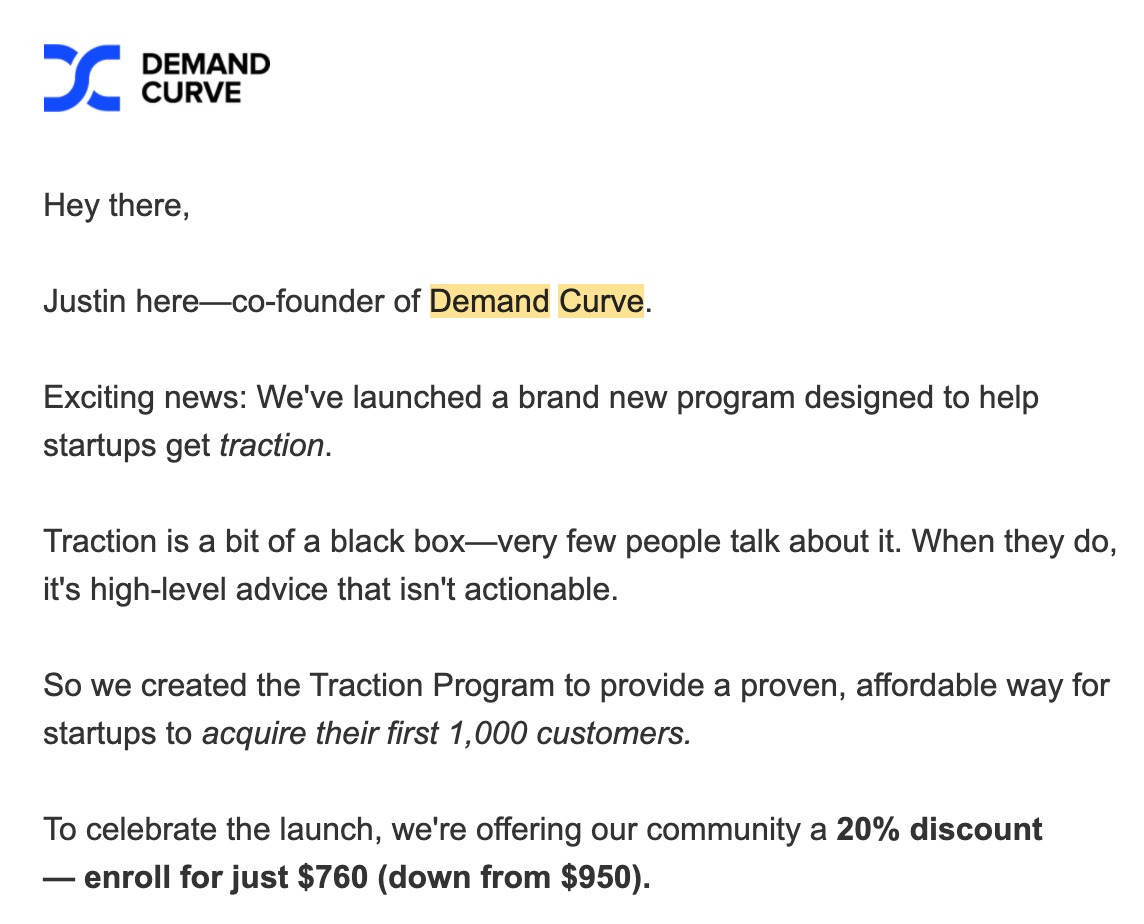
3. Account-based marketing
Account-based marketing (ABM) is a type of B2B marketing that focuses on aligning marketing and sales to reach specific target accounts.
ABM considers target accounts as markets-of-one and emphasizes the quality of accounts over the number of leads.
Read our beginner’s guide below to learn how to execute ABM for your business.
Recommended reading: The Beginner’s Guide to Account-Based Marketing (ABM)
4. Digital advertising
Digital advertising is easy to understand: pay a platform (e.g., Facebook, Twitter, YouTube, etc.) and drive traffic from that platform to your site. It is direct, measurable, and scalable. You can use it for any marketing campaign: lead generation, content promotion, and more.
At Ahrefs, we use paid ads primarily to promote our content. Since we promote our product in every piece of content we produce, each article acts as an “educational sales page.”
Driving paid eyeballs to our content means we get to educate our potential customers while showing them how our product fits into their marketing strategy.
Recommended reading: PPC Marketing: Beginner’s Guide to Pay-Per-Click Ads
5. Public relations (PR)
In June 2021, we were featured on Tech In Asia:

By appearing on notable and authoritative publications, you can improve your brand awareness, build credibility, earn backlinks, drive referral traffic, and engage your target audience.
The easiest way to begin getting PR is by using HARO. HARO is a free service that connects journalists with industry experts. Subscribe and you’ll receive emails with inquiries from journalists and bloggers.
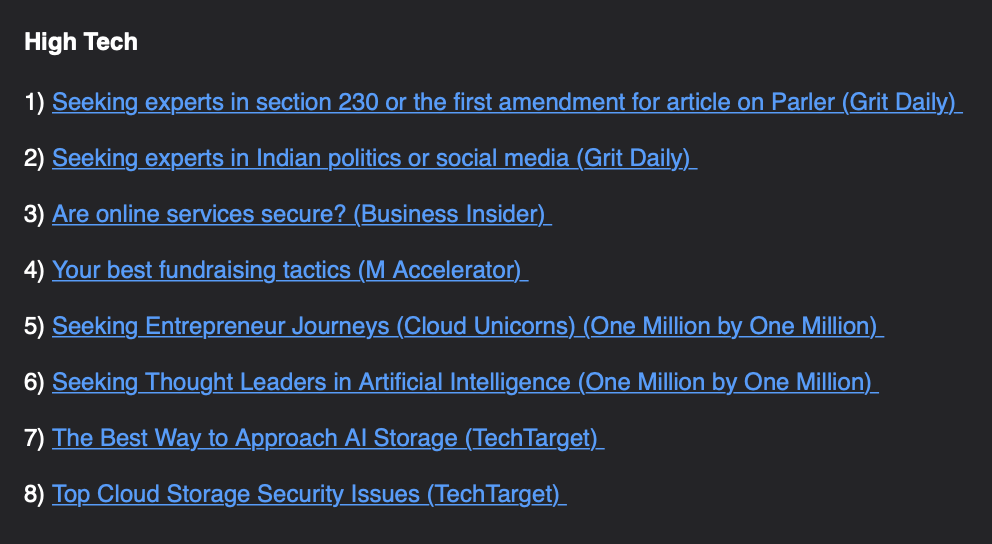
Here are some tips from my colleague, Michal Pecánek, to help boost your chances of getting a feature from them:
- Check the publication – You should avoid those that aren’t authoritative.
- Be picky – You should only respond to requests where you can truly provide great information.
- Respond as fast as possible – Many people are monitoring the same niche as you, so respond as quickly as you can.
- Get help – Don’t hesitate to bring colleagues on board if they’re more qualified to answer.
- Stick to the script – Don’t deviate from the format the author is requesting.
Recommended reading: 9 Great Public Relations Tactics With Campaign Examples
6. Events and trade shows
Nothing beats a handshake and a face-to-face meeting. As such, events can be a productive marketing channel, especially if you’re selling to larger accounts.
For example, Ogilvy Consulting hosts NudgeStock, an annual behavioral science conference. This attracts executives from all around the world interested in using behavioral science to solve problems, which is exactly what Ogilvy Consulting does.
Though organizing events can give your brand a huge boost, you don’t necessarily have to do that. Participating in events is worthwhile too. Even better: If you have the required expertise, you can appear as an expert on a panel or as a speaker.
Wow!
— Tim Soulo (@timsoulo) May 4, 2021
I didn’t expect to end up being the #1 trending speaker of the day at @AdWorldOfficial 😮
HUGE THANKS to everyone who supported my talk!
🙏🙏🙏🙏🙏🙏🙏 pic.twitter.com/QbOAxTNOCZ
As the current global situation makes it difficult to meet in person, virtual events work too. For example, NudgeStock went virtual for its 2021 conference. SaaS company Drift also created a virtual summit:

7. Social media
Social media may seem out of place for B2B marketing, but don’t forget that business-to-business marketing is ultimately still people-to-people marketing. No matter the decision-maker’s title or position, they still use social media on a regular basis.
However, don’t rush into the latest social network just because it’s currently hot. Focus on the platforms where your customers are—you should know this from your strategy.
For example, most SEOs are active on Twitter and LinkedIn, which is why those are the platforms we’re most active on.
NEW: Site Audit now stores full HTML and page text!
— Ahrefs (@ahrefs) December 1, 2021
After finishing a crawl, you can now search for anything within the HTML code and text content of your pages. pic.twitter.com/8vIjDA2bNG
Here are some examples of successful B2B marketing.
1. HubSpot – inbound marketing
HubSpot’s marketing approach is simple:
- Create content that ranks for keywords its target customers are searching for
- Offer content upgrades to encourage email sign-ups
- Get sales teams to contact these leads (this depends on different touchpoints)
Today, HubSpot’s blog generates an estimated 7.7M monthly organic search visits:

Coining this strategy “inbound marketing,” HubSpot has grown into the behemoth it is today. Many B2B companies have since adopted a similar approach.
2. MeetEdgar – podcast appearances
MeetEdgar is a social media automation tool founded in 2014. In 2019, it shared that it had crossed $2M in ARR.
Its main strategy is podcast appearances. The founder, Laura Roeder, knows her target audience—entrepreneurs and marketers—listens to podcasts. So by appearing on related podcasts, she can promote her company and acquire links from these sites.
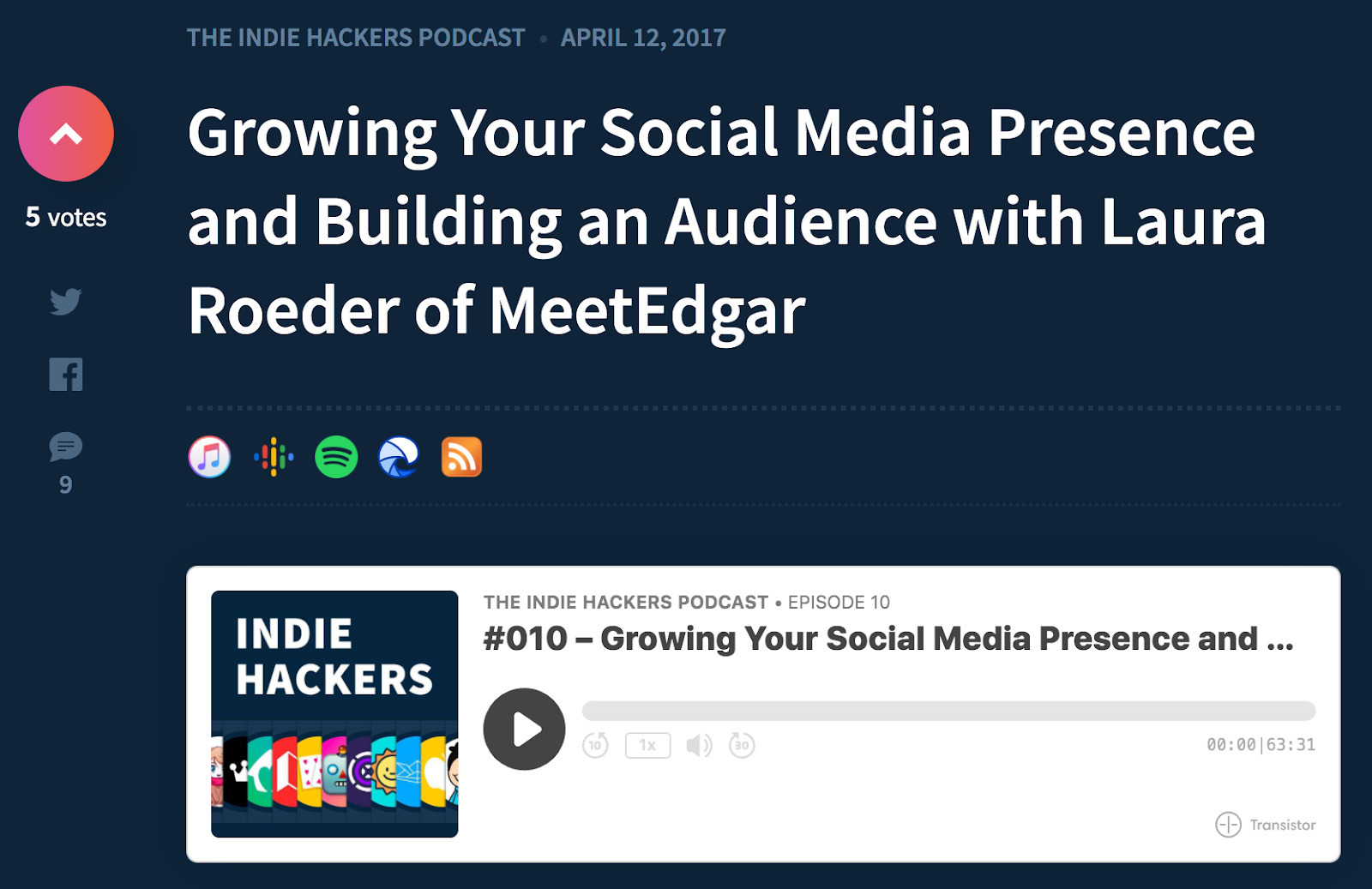
In total, Laura appeared on an estimated 100 podcasts. This strategy, according to ex-employee Jen Carvey, has grown MeetEdgar to 1.25M website visitors and 100K email subscribers.
3. Snowflake – SEO and ABM
Snowflake is a cloud computing-based data warehousing company. With an ARR of $600M and an oversubscribed IPO, its success stems from its marketing strategy.
First and foremost, Snowflake took the time to figure out a unique positioning strategy to stand out from its competitors. Its positioning—“The Data Warehouse Built for the Cloud”—took the company from $0 to $100M.
As you can see, your marketing strategy and positioning matter.
Since its main customers are enterprise accounts, Snowflake chose ABM as its main marketing tactic. By aligning its sales and marketing teams, it creates targeted pieces of content that guide its enterprise prospects down the buyers’ journey.
Recommended reading: The SEO & ABM Blueprint for Snowflake’s MASSIVE IPO
Final thoughts
B2B marketing isn’t about executing as many tactics as possible. It’s about creating a strategy and then only executing tactics that move the business forward.
But bear in mind that it doesn’t mean you’re limited to just one marketing channel. You can use as many tactics as required, as long as they fit your strategy.
Did I miss out on anything important about B2B marketing? Let me know on Twitter.




